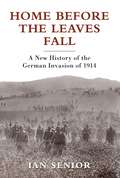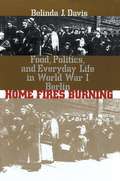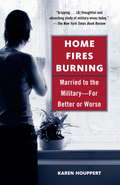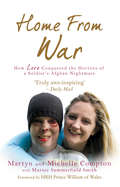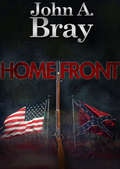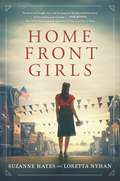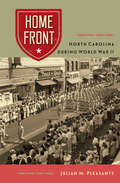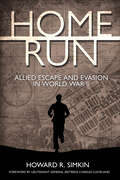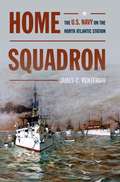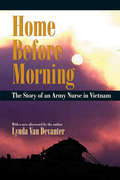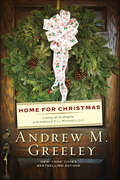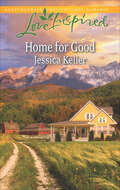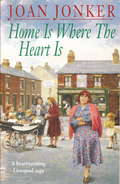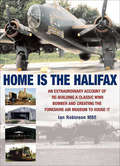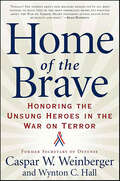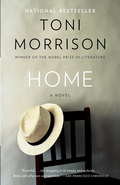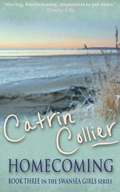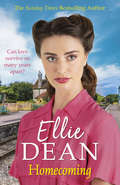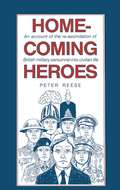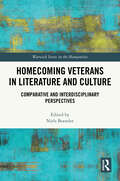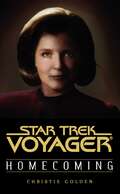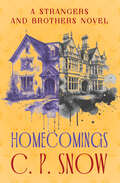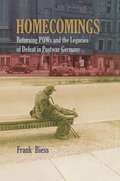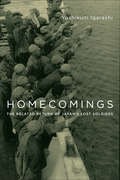- Table View
- List View
Home Before the Leaves Fall
by Ian SeniorThe German invasion of France and Belgium in August 1914 came within an ace of defeating the French armies, capturing Paris, and ending the First World War before the autumn leaves had fallen. But the German armies failed to score the knock-out blow they had planned. The war would drag on for four years of unprecedented slaughter. There are many accounts of 1914 from the British point of view. The achievements of the British Expeditionary Force were the stuff of legend, but in reality there were only four divisions in the field; the French and Germans had more than 60 each. The real story of the battle can only be told by an author with the skill to mine the extensive German and French archives. Ian Senior does this with consummate skill, weaving together strategic analysis with diary entries and interview transcripts from the soldiers on the ground to create a remarkable new history. In addition, all previous classic histories on the subject either focus virtually exclusively on the British experiences or are now very out-of-date such as Barbara Tuchman's Guns of August (1962) or Sewell Tyng's Campaign of the Marne (1935).Supported by up numerous sketch maps, extensive archival research and poignant first-hand accounts, Home before the leaves fall is an accessible, narrative account of the German invasion that came within an ace of victory, that long hot summer.
Home Fires Burning
by Belinda J. DavisChallenging assumptions about the separation of high politics and everyday life, Belinda Davis uncovers the important influence of the broad civilian populace--particularly poorer women--on German domestic and even military policy during World War I.As Britain's wartime blockade of goods to Central Europe increasingly squeezed the German food supply, public protests led by "women of little means" broke out in the streets of Berlin and other German cities. These "street scenes" riveted public attention and drew urban populations together across class lines to make formidable, apparently unified demands on the German state. Imperial authorities responded in unprecedented fashion in the interests of beleaguered consumers, interceding actively in food distribution and production. But officials' actions were far more effective in legitimating popular demands than in defending the state's right to rule. In the end, says Davis, this dynamic fundamentally reformulated relations between state and society and contributed to the state's downfall in 1918. Shedding new light on the Wilhelmine government, German subjects' role as political actors, and the influence of the war on the home front on the Weimar state and society, Home Fires Burning helps rewrite the political history of World War I Germany.
Home Fires Burning
by Karen HouppertAs taps echoes across the cookie-cutter housing areas of upstate New York’s Fort Drum, the wives turn on the evening news, both hoping for and dreading word of their husbands overseas. It’s a ritual played out on military bases across the nation as the waiting wives of Karen Houppert’s extraordinary new book endure a long, lonely, and difficult year with their husbands far from home. Houppert, a prize winning journalist, spent a year among these women, joining them as they had babies, raised families, ran Cub Scout troops, coached soccer–and went to funerals. The waiting wives include Lauren, twenty-six, whose Navy SEAL husband was killed in Afghanistan; Heidi, peace activist and Army wife whose life is a daily struggle with her conscience; Crystal, a nineteen-year-old raising two babies on a shoestring while her husband fights in the Middle East; Tabitha, who becomes the alleged victim of murderous domestic violence at the hands of her Special Operations boyfriend; and Danette, once an Army brat and now a devoted Air Force wife, who teaches, raises two teens, and fills her days with endless volunteer work. Houppert shows that these women make some of the same sacrifices of their personal liberties as their husbands do and yet garner none of the respect accorded their spouses. Today, these military wives find themselves torn between an entrenched tradition that would keep them in a Leave It to Beaver family ideal and a modern social climate suggesting that women are entitled to more–a career of their own, self-determination, and a true parenting partner. Meanwhile, the military concocts family-friendly policies and spends millions on new programs designed to appease military wives–and to maintain them as staunch supporters who will encourage their husbands’ reenlistment. The Army likes to say that it “recruits soldiers, but retains families. ” And indeed, the future of the all-volunteer force hinges on the success ofthismission. Though Army brass speak glowingly of the “Army Family Team,” this team is often deeply divided over strategy–and even goals. A gritty, behind-the-scenes look at the tour of duty from the domestic front, Home Fires Burning provides a fascinating, fresh look at an enormous American institution and the families that live in its shadow. From the Hardcover edition.
Home From War: How Love Conquered the Horrors of a Soldier's Afghan Nightmare
by Marnie Summerfield Smith Martyn Compton Michelle ComptonLance Corporal Martyn Compton's life was changed beyond recognition when he was blown up in a Taliban ambush that killed three of his colleagues. His survival was described as a 'miracle', as he suffered third-degree burns to 75 per cent of his body. He endured 15 operations and doctors used shark cartilage as a base for new skin on his face.But he did not have to face this gruelling ordeal alone. From the moment she heard of his near-fatal wounds, Martyn's fiancée Michelle Clifford found an inner strength to help them both face the future. During Martyn's treatment, Michelle kept a diary in which she revealed the innermost thoughts and emotions she wished she could relay to her wounded partner.Home From War gives a rare insight into the story behind the headlines when soldiers die or are injured. It is also the account of Martyn's battle for adequate compensation. This exploration of how one courageous man came to terms with losing his handsome young face cannot fail to inspire.
Home Front
by John A. BrayThe author of Flags of Our Sonsdelivers an immaculately researched, fast-paced thriller that plunges the reader right into the intrigue of the Civil War. A young and penniless boy, Johnny Madigan lies about his age to become a Union soldier. But after fighting his way through some of the most brutal conflicts of the American Civil War and surviving terrible wounds, Johnny now faces an even deadlier battlefield: he must fight on the home front. Johnny has proven himself a skilled spy. His commanders send him back to New York to penetrate an underground counterfeiting gang supplying forged US currency to the South. As he infiltrates the deadly cabal of plotters, he is sent to Canada where a murderous Confederate spy ring is plotting an armed uprising to take over New York City and hold it hostage—and so win the war for the Confederacy. But in Canada, it is impossible for Johnny to tell which side is which. Suspected by some of the plotters, he is seduced by the beautiful Letitia—a key member of the gang. Her orders are to expose him. Johnny dreams of returning to his childhood sweetheart, the girl who kept him alive as a destitute youth in the city’s slums. But Letitia is proving difficult to resist. At stake are Johnny’s heart, his life—and the outcome of the Civil War itself. “This is the Civil War in close-up, in all its fury and glory. A fantastic, captivating read.” —Richard Foreman, author of the Spies of Rome series
Home Front Girls
by Loretta Nyhan Suzanne HayesDear Glory,Loneliness is built into the fabric of this war, isn’t it? I say a little prayer before I stick my hand in the mailbox. The “Rockport, Massachusetts” stamp on the front of an envelope means the clouds will part, revealing a brilliant sun….It’s January 1943 when Rita Vincenzo receives her first letter from Glory Whitehall. Glory is an effervescent young mother from New England, impulsive and free as a bird. Rita is a Midwestern professor’s wife with a love of gardening and a generous, old soul. These two women have nothing in common except one powerful bond: the men they love are fighting in a war a world away from home.Brought together by an unlikely twist of fate, Glory and Rita begin a remarkable correspondence. The friendship forged by their letters allows them to survive the loneliness and uncertainty of waiting on the home front, and gives them the courage to face the battles raging in their very own backyards. Connected across the country by the lifeline of the written word, each woman finds her life profoundly altered by the other’s unwavering support.Filled with unforgettable characters and unbridled charm, Home Front Girls is a timeless celebration of the strength and solidarity of women. It is a luminous reminder that even in the darkest of times, true friendship will carry us through.Previously published as I’LL BE SEEING YOU.
Home Front: North Carolina during World War II
by Julian M. PleasantsAt the outset of World War II, North Carolina was one of the poorest states in the Union. More than half of the land was rural. Over one-third of the farms had no electricity; only one in eight had a telephone. Illiteracy and a lack of education resulted in the highest rate of draft rejections of any state. The citizens desperately wanted higher living standards, and the war would soon awaken the Rip Van Winkle state to its fullest potential. Home Front traces the evolution of the people, customs, traditions, and attitudes, arguing that World War II was the most significant event in the history of modern North Carolina. Using oral history interviews, newspaper accounts, and other primary sources, historian Julian Pleasants explores the triumphs, hardships, and emotions of North Carolinians during this critical period. The Training and Selective Service Act of 1940 created over fifty new military bases in the state to train two million troops. Citizens witnessed German submarines sinking merchant vessels off the coast, struggled to understand and cope with rationing regulations, and used 10,000 German POWs as farm and factory laborers. The massive influx of newcomers reinvigorated markets--the timber, mineral, textile, tobacco, and shipbuilding industries boomed, and farmers and other manufacturing firms achieved economic success. Although racial and gender discrimination remained, World War II provided social and economic opportunities for black North Carolinians and for women to fill jobs once limited to men, helping to pave the way for the civil and women's rights movements that followed. The conclusion of World War II found North Carolina drastically different. Families had lost sons and daughters, fathers and mothers, and brothers and sisters. Despite all the sacrifices and dislocations, the once provincial state looked forward to a modern, diversified, and highly industrialized future.
Home Run: Allied Escape and Evasion in World War II
by Howard R. Simkin"This book belongs on every World War II bookshelf, filling in the gaps on what is known about this oft-mentioned but little understood topic of wartime escape and evasion." —The NYMAS ReviewImagine that you are deep behind enemy lines. Your plane was shot down or perhaps you have just escaped from a prisoner of war camp. The enemy is hunting you, seeking to throw you behind barbed wire for the duration of the war. What will you do? Do you have a plan, and the skills, to make it to friendly territory? During World War II, the Germans and Japanese held over 306,000 British and 105,000 U.S. service members as prisoners. The number of successful evaders and escapers, both U.S. and British, exceeded 35,000. Many of these were aircrew, who received intense training because of the high risk that they would have to evade or escape. This book will relate how they fared in enemy hands or managed to remain free. This book provides a complete overview of U.S. and British escape and evasion during World War II. It tells the story of the escape and evasion organizations, the Resistance-operated lines, and the dangers faced by the escapers and the evaders in a logical and compelling narrative. Heroism, betrayal, sacrifice, and cowardice are all elements of this fascinating part of the rich tapestry of World War II.
Home Squadron
by James C. RentfrowThis study examines the transformation of the United States Navy as a fighting organization that took place on the North Atlantic Station between 1874 and 1897. At the beginning of this period, the warships assigned to this station were collectively administered by a rear-admiral, but were operationally deployed as individual units, each of whose actions were directed by their captains. By 1897 the North Atlantic, or "Home" Squadron as it was known, was a group of warships constituting a protean battle fleet - that is, an organized body moving and fighting in close-order, which meant that the actions of the captains were directed by a commanding admiral. The process of the development of an American battle fleet resulted in the construction of a new organizational identity for the North Atlantic Squadron. This process was as critical as the eventual outcome. It was not linear, but one in which progress in critical areas was modulated by conflicting demands that caused distraction. From 1874-1888, exercises in fleet tactics under steam were carried out sporadically utilizing existing wooden cruising vessels. From 1889-1894, the last wooden cruisers were decommissioned and the Squadron consisted entirely of new steel warships. Ad-hoc concentrations of vessels for purposes besides exercise and training retarded the continued development of doctrine and tactics necessary for a multi-ship fighting capability during this time. However, much work was done to develop a concept of multi-ship operations. From 1895-1897, the identity of the North Atlantic Squadron as a combat unit solidified. Tactical exercises were held that had specific offensive and defensive wartime applications. These exercises were necessary to develop a combat capability. The results of this study demonstrate that the United States government had an interest in developing an offensive naval combat capability as early as the 1870's. Based on the record of the North Atlantic Squadron, it is argued that imperial aspirations, in the sense of possessing a capability to restrict the actions of other great powers in the Caribbean region, existed prior to the War of 1898. However, the process of change often resulted in the appearance of capability without the rigorous exercise necessary to possess it.
Home before Morning: The Story of an Army Nurse in Vietnam
by Lynda van Van DevanterLynda Van Devanter was the girl next door, the cheerleader who went to Catholic schools, enjoyed sports, and got along well with her four sisters and parents. After high school she attended nursing school and then did something that would shatter her secure world for the rest of her life: in 1969, she joined the army and was shipped to Vietnam. When she arrived in Vietnam her idealistic view of the war vanished quickly. She worked long and arduous hours in cramped, ill-equipped, understaffed operating rooms. She saw friends die. Witnessing a war close-up, operating on soldiers and civilians whose injuries were catastrophic, she found the very foundations of her thinking changing daily. After one traumatic year, she came home, a Vietnam veteran. Coming home was nearly as devastating as the time she spent in Asia. Nothing was the same -- including Lynda herself. Viewed by many as a murderer instead of a healer, she felt isolated and angry. The anger turned to depression; like many other Vietnam veterans she suffered from delayed stress syndrome. Working in hospitals brought back chilling scenes of hopelessly wounded soldiers. A marriage ended in divorce. The war that was fought physically halfway around the world had become a personal, internal battle.Home before Morning is the story of a woman whose courage, stamina, and personal history make this a compelling autobiography. It is also the saga of others who went to war to aid the wounded and came back wounded -- physically and emotionally -- themselves. And, it is the true story of one person's triumphs: her understanding of, and coming to terms with, her destiny.
Home for Christmas: A Novel
by Andrew M. GreeleyPetey Pat Kane and Mariana Pia Pelligrino have been in love with each other their whole lives. But on a night that is supposed to be one of the best of their lives, Peter makes a choice that forces him to leave Chicago—and Mariana—behind. Guilt leads him into the Army, where he becomes Captain Kane, war hero. But nothing can make him forget his love for Mariana.On his third deployment in Iraq, Peter is injured and finds himself both alive and dead on a wondrous spiritual journey where he is given a second chance at life from God Himself. With Christmas approaching, time is running out for Peter to complete the most important mission of his life: convincing himself that he and Mariana were meant to share a special message of love with the world. At the Publisher's request, this title is being sold without Digital Rights Management Software (DRM) applied.
Home for Good
by Jessica KellerAn injured veteran returns to his cowboy home—and the family he’s determined to win back and protect from harm—in this heartwarming romance.Ali Silver’s husband made a promise to protect her. But then he broke his vow and walked away from her. After being injured in combat, Jericho has finally come home to Bitterroot Valley to make peace with his father—and regain Ali’s trust. But the single mom’s keeping secrets of her own.Someone’s killing off Ali’s cattle and sabotaging her horse therapy business. Now Jericho will do whatever it takes to protect his wife and be a real father to his son. Because when it comes to love and second chances, he’s one determined cowboy.
Home is Where the Heart Is: A touching saga of love, family and hope (Eileen Gillmoss series, Book 3)
by Joan JonkerWhen tragedy strikes, a young mother's friends and family ensure she is never alone... Joan Jonker's saga, Home is Where the Heart Is, brings to life a close-knit Liverpudlian community, in the final instalment of the Eileen Gillmoss series. Perfect for fans of Katie Flynn and Dilly Court.'Warm, witty... loved by her legions of fans' - Liverpool EchoWhen fun-loving, eighteen-stone Eileen Gillmoss announces that she's expecting a baby, her husband Bill thinks it's another one of her jokes. After all, it's twelve years since Edna, their youngest, was born. But when it sinks in that a baby really is on the way, Bill is over the moon and decides that the family should move out of their two-up, two-down house in Liverpool to one with more spacious accommodation. Eileen digs her heels in at first, reluctant to leave the house she loves and friends and neighbours so dear. But a scare early in Eileen's pregnancy strengthens Bill's resolve to provide a more comfortable home for his wife. Before Eileen knows what's hit her, she's installed in a smart home with posh new neighbours. Then tragedy strikes and Eileen must come to terms with a loss far greater than leaving behind her beloved neighbourhood. She tries to put on a brave face, but she can't fool the people who love her, who miss the smile on that round, chubby face and the laughter ringing through her house. They vow to make amends and fate steps in to lend a helping hand... What readers are saying about Home is Where the Heart Is: 'From the first page you are drawn into this wonderful woman's life and family as if you belong there. Joan Jonker creates a web of family crises and tragedies mixed with the never flagging spirit of Eileen Gilmoss to keep you hungry for more' 'As always with Joan it's a mix of hard, nitty, gritty life and fun thrown into the mix, never a dull moment with her books, tears of woe one minute and laughter the next'
Home is the Halifax: An Extraordinary Account of Re-Building a Classic WWII Bomber and Creating the Yorkshire Air Museum to House It
by Ian RobinsonA World War II veteran details wartime life in Yorkshire and his postwar efforts to build a museum and restore a Halifax bomber. Between 1935 and 1945, Yorkshire became home to 41 military airfields, the majority located in the Vale of York. The area was often referred to as a land-based aircraft carrier. At 16, Ian Robinson began working for the Handley Page aircraft manufacturer at their repair depot at Clifton, York. There, Halifax bombers used by 4 Group RAF and 6 Group Royal Canadian Air Force were repaired and test flown. During the Second World War, about 30 squadrons operated from these Yorkshire airfields, and the Book of Remembrance in York Minster records more than 18,000 names of those killed flying from these Yorkshire bases. Postwar, Ian felt aggrieved that little was left commemorating these sacrifices and that little was left of the Halifax bomber. Then in 1983, a small group of aviation enthusiasts got together to create a commemorative museum at Elvington, and Ian joined them. He became a pivotal player in forming the Yorkshire Air Museum and Allied Air Forces Memorial. Yet Ian felt the museum was incomplete without a Halifax. So, starting with a derelict fuselage which was being used as a hen-coop on the Isle of Lewis, he set about gathering all the hundreds of bits needed to reassemble the aircraft. This is Ian&’s account of those 13 extraordinary years before the Friday the 13th was rolled out on Friday, September 13, 1996.
Home of the Brave: Honoring the Unsung Heroes in the War on Terror
by Caspar W. Weinberger Wynton C. HallIn Home of the Brave, former Secretary of Defense Caspar W. Weinberger brings us a chronicle of heroism in the War on Terror.They are nineteen of the most highly decorated soldiers, sailors, airmen, and marines in the United States military, and yet most Americans don't even know their names. In this riveting, intimate account, former Secretary of Defense Caspar Weinberger and Wynton C. Hall tell stories of jaw-dropping heroism and hope in Afghanistan and Iraq. Home of the Brave takes readers beyond the bullets and battles and into the hearts and minds of the men and women who are fighting terrorists overseas so that America doesn't have to fight them at home. These are the powerful, true-life stories of the hopes, fears, and triumphs these men and women experienced fighting the War on Terror. But more than that, these are the stories of soldiers who risked everything to save lives and defend freedom. Including:*Lieutenant Colonel Mark Mitchell, the Green Beret leader whose 15-man Special Forces team took 500 Al Qaeda and Taliban prisoners, and posthumously repatriated the body of the first American to die in combat in the War on Terror, CIA agent Johnny "Mike" Spann.*Army National Guard Sergeant Leigh Ann Hester, the first woman ever to be awarded the Silver Star for combat, whose sharp-shooting and bravery played an enormous role in fighting off over fifty Iraqi insurgents while her ten-person squad protected a convoy of supplies on the way to fellow soldiers. *Sergeant Rafael Peralta, a Mexican immigrant, enlisted in the Marines the same day he received his green card. Wounded from enemy fire, Peralta used his body to smother the blast of an enemy grenade and gave his life so that his marine brothers could live. These real-life heroes remind us of American history's most enduring lesson: Ours would not be the land of the free if it were not also the home of the brave.At the Publisher's request, this title is being sold without Digital Rights Management Software (DRM) applied.
Home to Wind River (Wind River #7)
by Lindsay McKennaThe new novel from the bestselling author of Lone Rider. For some, love is the only medicine . . . >{?>{?After a harrowing tour of duty in Afghanistan, Army nurse Lily Thompson escapes to Wind River Ranch to find herself once more. Working as a caregiver to foreman Jake Murdoch’s elderly mother, Lily almost feels at peace—except for the unsettling presence of Jake, a tight-lipped, intimidating man everyone calls Bear. But one look in the powerful ex-Marine’s eyes and Lily glimpses a vulnerability that shakes her soul: a hurt she understands all too well—and longs to heal . . . <P><P>Jake is ready to rail at the fates when Lily moves into his home. Everything about this captivating woman calls to him, demanding that he abandon his solitary stance and start to live again. But Jake is a man who knows that no one can save him from the past that stalks his heart and mind. Not even sweet, achingly beautiful Lily. Still, that doesn’t stop his longing to pull her into his arms—and keep her there forever. Will time, and patience, bring them the courage to make their connection real? . . .
Home: A novel (Vintage International)
by Toni MorrisonThe latest novel from Nobel Prize winner Toni Morrison.An angry and self-loathing veteran of the Korean War, Frank Money finds himself back in racist America after enduring trauma on the front lines that left him with more than just physical scars. His home--and himself in it--may no longer be as he remembers it, but Frank is shocked out of his crippling apathy by the need to rescue his medically abused younger sister and take her back to the small Georgia town they come from, which he's hated all his life. As Frank revisits the memories from childhood and the war that leave him questioning his sense of self, he discovers a profound courage he thought he could never possess again. A deeply moving novel about an apparently defeated man finding his manhood--and his home.This eBook edition includes a Reading Group Guide.
Homecoming
by Catrin CollierDr Grace Harper has loved the stories of Robin Hood ever since she first saw them on TV as a girl. Now, with her fortieth birthday just around the corner, she's a successful academic in Medieval History, with a tenured position at a top university. But Grace is in a bit of a rut. She's supposed to be writing a textbook on a real-life medieval gang of high-class criminals - the Folvilles - but she keeps being drawn into the world of the novel she's secretly writing - a novel which entwines the Folvilles with her long-time love of Robin Hood - and a feisty young girl named Mathilda, who is the key to a medieval mystery... Meanwhile, Grace's best friend Daisy - who's as keen on animals as Grace is on the Merry Men - is unexpectedly getting married, and a reluctant Grace is press-ganged into being her bridesmaid. As Grace sees Daisy's new-found happiness, she starts to re-evaluate her own life. Is her devotion to a man who may or may not have lived hundreds of years ago really a substitute for a real-life hero of her own? It doesn't get any easier when she meets Dr Robert Franks - a rival academic who Grace is determined to dislike but finds herself being increasingly drawn to...
Homecoming (The Cliffehaven Series #18)
by Ellie Dean**************THE EIGHTEENTH CLIFFEHAVEN NOVEL BY SUNDAY TIMES BESTSELLING AUTHOR ELLIE DEANPeace has finally been declared in the Far East, but for those living at Beach View Boarding House, the news brings mixed emotions. Peggy Reilly is devastated that her husband Jim will not be coming home for Christmas. And Sarah and Jane, who have lived at Beach View throughout much of the conflict, dread what they will find when they go back to Singapore. Life in Cliffehaven is in a whirlwind of change as the men return from the war and Peggy’s evacuee chicks begin to spread their wings and start new lives in different corners of the world.Peggy and Jim have longed to be together after so many years apart, but war has left them profoundly changed. Can they rekindle the loving, close relationship they’d shared before?
Homecoming Heroes: An Account of the Re-assimiliation of British Military Personnel into Civilian Life
by Peter ReeseIt is a sad and shaming but indisputable fact that the reception according to British soldiers on returning to civilian life has for centuries been little short of disgraceful, and even in this more enlightened age compares unfavourably with that of many other countries. In Homecoming Heroes Peter Reese ex-amines the lot of British veteran (often still quite a young man) on leaving the Armed Forces and assesses the chances of finding suitable employment after his discharge. His survey covers a wide canvas, going back to the earliest days of the British Army and reveals a sorry tale in which neglect was often the only alternative to downright hostility. It is not a story to swell the British breast with pride. The efforts of Charles II, founder of Chelsea Royal Hospital, and later those of the benevolent Marquis of Granby notwithstanding, it was not until the later part of the 19th century that an awakening of social conscience stirred certain philanthropic individuals into action. Ironically Government reaction was not to the veterans advantage: 'If the matter is now in private hands' they argues, 'why should we interfere?' Mass conscription in two world wars has helped considerable to help break down this uncaring viewpoint, but much, as Peter Reese forcefully points out, remains to be done. Let us hope that this timely book will help ameliorate the lot of those about to be cast upon a shrinking job market as a result of the recently announced defence cuts.
Homecoming Veterans in Literature and Culture: Comparative and Interdisciplinary Perspectives (Warwick Studies in the Humanities)
by Niels BoenderFrom Homer’s Odyssey itself, the return of the veteran to his or her home has been a central trope of the literary canon. Huge bureaucracies and a panoply of global organisations are deeply concerned with facilitating a painless return to stable homes. This book presents ‘homecoming’ as an analytical lens to better understand veterans’ return and reintegration after conflict. Home is held to be multidimensional, a concept encapsulating the physical and the social, particularly disrupted by experiences of violence. Homecoming is, therefore, not a mere moment but a process that can unfold over years and decades as old and new bonds of familiarity are forged. Struggles over the home and homecoming are, moreover, endlessly political, bound up in questions of identity and the nation. Looking across times, places, and disciplines, the collection centres both historical and representational approaches to veterancy.
Homecoming: Star Trek Voyager (Star Trek: Voyager #1)
by Christie GoldenThis thrilling adventure from Star Trek: Voyager follows Kathryn Janeway and her crew as they return home, only to face a devastating plague.After seven long years in the Delta Quadrant, the crew of the USS Voyager now confront the strangest world of all: home. For Admiral Kathryn Janeway and her stalwart officers, Voyager&’s miraculous return brings new honors and responsibilities, reunions with long-lost loved ones, and for some, such as the Doctor and Seven of Nine, the challenge of forging new lives in a Federation that seems to hold little place for them. But even as Janeway and the others go their separate ways, pursuing new adventures and opportunities, a mysterious cybernetic plague strikes Earth, transforming innocent men, women, and children into an entirely new generation of Borg. Now the entire planet faces assimilation, and Voyager may be to blame!
Homecomings (The Strangers and Brothers Novels)
by C.P. SnowAn emotionally devastated widower is drawn to a married woman in this &“impressive&” novel set in wartime England (Kirkus Reviews). Lewis Eliot has lost his deeply troubled wife, Sheila, under tragic circumstances. While her suicide has shaken Lewis to his core, it has also put an end to a painful and difficult marriage. In the wake of Sheila&’s passing and Britain entering the Second World War, Lewis plunges into his civil service work. During this time, he meets Margaret and begins to feel his heart stirring—and sees the possibility of healing. But Margaret already has a husband, severely complicating the attraction they both feel, in this series of historical novels that the Telegraph called &“Balzacian masterpieces of the age.&” &“A master craftsman in fiction.&” —The New York Times &“An extremely shrewd observer of men and society.&” —Commentary
Homecomings: Returning POWs and the Legacies of Defeat in Postwar Germany
by Frank BiessThis book focuses on one of the most visible and important consequences of total defeat in postwar Germany: the return to East and West Germany of the two million German soldiers and POWs who spent an extended period in Soviet captivity. These former prisoners made up a unique segment of German society. They were both soldiers in the war of racial annihilation on the Eastern front and then suffered extensive hardship and deprivation themselves as prisoners of war. The book examines the lingering consequences of the soldiers' return and explores returnees' own responses to a radically changed and divided homeland. Historian Frank Biess traces the origins of the postwar period to the last years of the war, when ordinary Germans began to face the prospect of impending defeat. He then demonstrates parallel East and West German efforts to overcome the German loss by transforming returning POWs into ideal post-totalitarian or antifascist citizens. By exploring returnees' troubled adjustment to the more private spheres of the workplace and the family, the book stresses the limitations of these East and West German attempts to move beyond the war. Based on a wide array of primary and secondary sources, Homecomings combines the political history of reconstruction with the social history of returnees and the cultural history of war memories and gender identities. It unearths important structural and functional similarities between German postwar societies, which remained infused with the aftereffects of unprecedented violence, loss, and mass death long after the war was over.
Homecomings: The Belated Return of Japan's Lost Soldiers (Studies of the Weatherhead East Asian Institute, Columbia University)
by Yoshikuni IgarashiSoon after the end of World War II, a majority of the nearly 7 million Japanese civilians and serviceman who had been posted overseas returned home. Heeding the call to rebuild, these veterans helped remake Japan and enjoyed popularized accounts of their service. For those who took longer to be repatriated, such as the POWs detained in labor camps in Siberia and the fighters who spent years hiding in the jungles of islands in the South Pacific, returning home was more difficult. Their nation had moved on without them and resented the reminder of a humiliating, traumatizing defeat. Homecomings tells the story of these late-returning Japanese soldiers and their struggle to adapt to a newly peaceful and prosperous society. Some were more successful than others, but they all charted a common cultural terrain, one profoundly shaped by media representations of the earlier returnees. Japan had come to redefine its nationhood through these popular images. Yoshikuni Igarashi explores what Japanese society accepted and rejected, complicating the definition of a postwar consensus and prolonging the experience of war for both Japanese soldiers and the nation. He throws the postwar narrative of Japan's recovery into question, exposing the deeper, subtler damage done to a country that only belatedly faced the implications of its loss.
